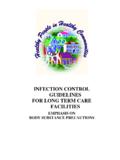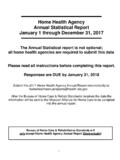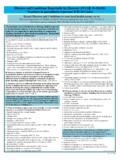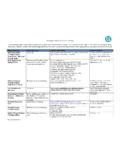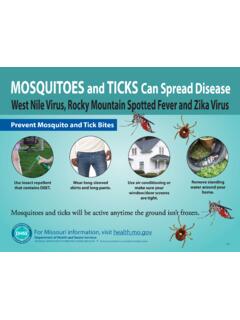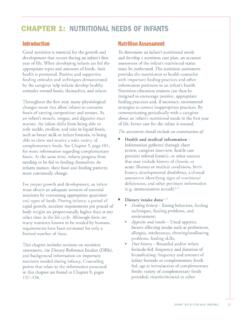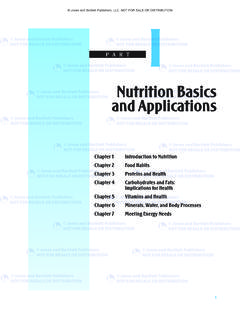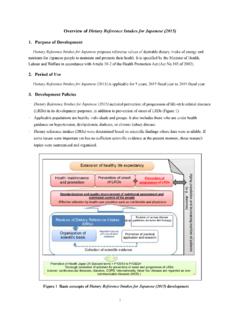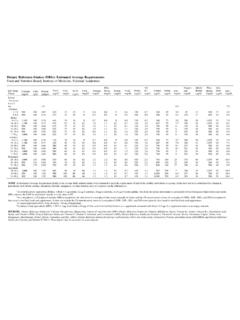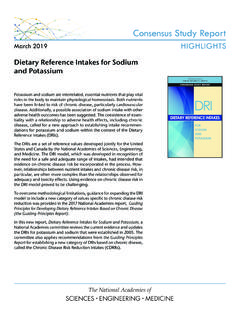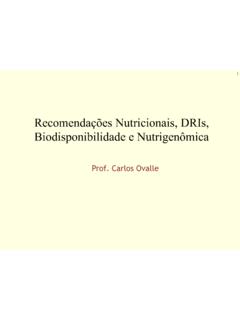Transcription of 341 Nutrient Deficiency or Disease.6
1 06/2018 1 of 7 341 Clinical/Health/Medical: Nutrient Deficiency or Disease 341 Nutrient Deficiency or Disease Definition/Cut-off Value Any currently treated or untreated Nutrient Deficiency or disease. These include, but are not limited to, Protein Energy Malnutrition, Scurvy, Rickets, Beriberi, Hypocalcemia, Osteomalacia, Vitamin K Deficiency , Pellagra, Xerophthalmia, and Iron Deficiency . Presence of condition diagnosed, documented, or reported by a physician or someone working under a physician s orders, or as self-reported by applicant/participant/caregiver.
2 See Clarification for more information about self-reporting a diagnosis. Participant Category and Priority Level Category Priority Pregnant Women I Breastfeeding Women I Non-Breastfeeding Women III, IV, V, or VI Infants I Children III Justification Nutrient deficiencies or diseases can be the result of poor nutritional intake , chronic health conditions, acute health conditions, medications, altered Nutrient metabolism, or a combination of these factors, and can impact the levels of both macronutrients and micronutrients in the body.
3 They can lead to alterations in energy metabolism, immune function, cognitive function, bone formation, and/or muscle function, as well as growth and development if the Deficiency is present during fetal development and early childhood. The Centers for Disease Control and Prevention (CDC) estimates that less than 10% of the United States population has Nutrient deficiencies; however, Nutrient deficiencies vary by age, gender, and/or race and ethnicity (1). For certain segments of the population, Nutrient deficiencies may be as high as one third of the population (1).
4 intake patterns of individuals can lead to Nutrient inadequacy or Nutrient deficiencies among the general population. Intakes of nutrients that are routinely below the dietary reference Intakes (DRI) can lead to a decrease in how much of the Nutrient is stored in the body and how much is available for biological functions. DRIs are based on age and sex and include Recommended dietary Allowance (RDA), Adequate intake (AI), Estimated Average Requirement (EAR) and Tolerable Upper intake Level (UL). DRIs are established by the National Academies of Science, Engineering and Medicine and include the following definitions: RDA - Indicates the average daily intake of particular nutrients to meet the requirements of 97-98% of healthy people.
5 AI - Established to assume adequate intake when there is insufficient evidence to develop an RDA. 06/2018 341 2 of 7 Clinical/Health/Medical: Nutrient Deficiency or Disease EAR - The average daily intake of a Nutrient that is thought to meet the needs of 50% of healthy individuals. EARs are used to assess the adequacy of Nutrient intakes among populations rather than the individual. UL - The highest Nutrient intake that is considered to be safe and does not lead to adverse health effects in the general population (2).
6 Macronutrient deficiencies include deficiencies in protein, fat, and/or calories, and can lead to stunting, pronounced wasting (marasmus) or a disproportionately large abdomen (a sign of kwashiorkor). Marasmus is a disease of severe wasting due to a prolonged inadequate intake of protein, carbohydrate, and fat. Kwashiorkor is a disease that results from a prolonged inadequate intake of protein. Essential fatty acid deficiencies, which would include omega-3 fatty acid Deficiency , are thought to be rare among the general population (3, 4).
7 Signs of an essential fatty acid Deficiency may include a dry scaly rash, decreased growth in infants and children, lowered immune response, and impaired wound healing (3). Micronutrient deficiencies would include deficiencies in vitamins and minerals in the body. According to National Health and Nutrition Examination Survey (NHANES) data, the most common Nutrient deficiencies from 2003-2006 in the general United States population were vitamin B6, iron, vitamin D, vitamin C, and vitamin B12 (1). Because NHANES does not assess the status of all vitamins and minerals, there may be other micronutrient deficiencies that are present in the population without an estimated prevalence.
8 According to NHANES data from 2005-2012, a significant proportion of women who participate in WIC have inadequate Nutrient intakes of vitamin E (96-100%). Additionally, greater than 50% of pregnant women participants reported inadequate intakes of iron and between 10-50% reported inadequate intakes of magnesium, folate, zinc, vitamin A, vitamin C, and vitamin B6 (5). Micronutrient deficiencies during pregnancy are not only a concern for the mother, but are of great concern to the developing fetus that is at risk of certain birth defects related to inadequate levels of certain nutrients including B vitamins, vitamin K, magnesium, copper, and zinc (6).
9 Iodine Deficiency during pregnancy can lead to irreversible adverse effects on fetal growth and development. Iodine Deficiency is the leading cause of intellectual disability worldwide. According to NHANES data from 2005-2008, of the pregnant women surveyed had urinary iodine concentrations below the established threshold of 150mcg/L. This finding suggests that greater than half of pregnant women have insufficient intakes of iodine (7). Because intake patterns of pregnant women can exclude or limit specific food groups, it is not uncommon to have multiple Nutrient deficiencies during pregnancy (8).
10 For example, iron Deficiency usually does not occur alone, but it often occurs in conjunction with other vitamin and mineral deficiencies (9). Intakes of nutrients were also found to be low among postpartum and breastfeeding women participating in WIC. Among women who were breastfeeding and participating in WIC, more than 50% had inadequate intakes of vitamin A, and 10-50% had inadequate intakes of magnesium, zinc, vitamin C, vitamin B6, folate, copper, and calcium (5). Greater than 50% of postpartum women who were not breastfeeding were found to have inadequate intakes of magnesium, vitamin A, and calcium, while 10-50% had inadequate intakes of vitamin C, folate, copper, zinc, thiamin, vitamin B6, vitamin B12, iron, and riboflavin (5).

